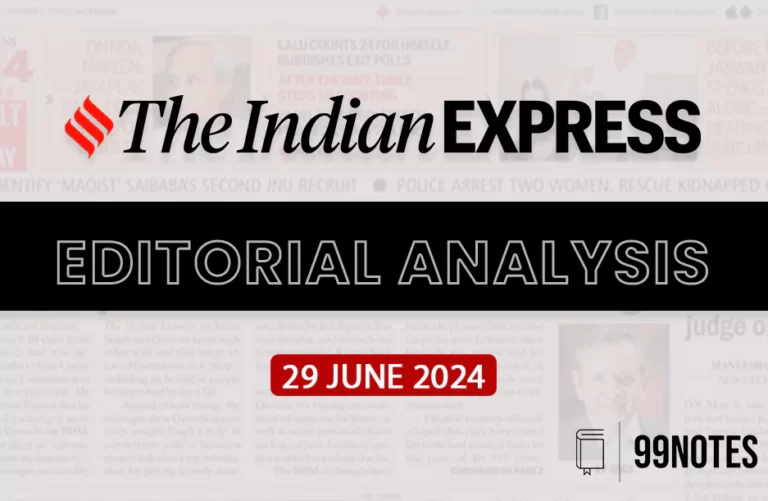8 Feb 2024 : Indian Express Editorial Analysis
Indian Express Editorial Analysis
8-February-2024
1. State is in the room
| Topic: GS2 – Polity – Indian constitution – Significant provisions This topic is relevant for both Prelims and Mains in the context of understanding the nuances of the proposed UCC and its alignment with Article 44 of the Indian Constitution. |
| Context: |
|
More about the news:
Debates Surrounding the UCC:
- The debates surrounding the UCC have been multifaceted, particularly concerning the modifications to personal laws.
- Issues such as marriage, divorce, inheritance, and succession have been subject to intense discussion, often entangled with concerns about majoritarian politics.
- Notably, there is apprehension regarding the potential infringement of fundamental rights, particularly when governmental definitions of “morality” are invoked.
Inclusivity and Rights Considerations:
- While the proposed legislation acknowledges “live-in relationships” and accommodates certain customs or usages governing such arrangements, it falls short of a fully inclusive rights-based approach.
- By defining these relationships strictly as those between a man and a woman, the legislation excludes individuals irrespective of sexual orientation.
- This exclusionary stance reflects a broader societal reluctance towards recognizing diverse forms of intimate partnerships.
Legal Precedents and Societal Norms:
- The proposed UCC draws from legal precedents, such as the recognition of relationships “in the nature of marriage” in case law.
- However, it diverges from progressive judicial rulings, such as those affirming consensual adult relationships and recognizing diverse family structures.
- The legislation’s failure to provide clarity on issues such as next-of-kin status and property rights reflects a reluctance to fully acknowledge the complexities of modern relationships.
Global Perspectives and Surveillance Concerns:
- Comparisons with global legislative frameworks, such as civil unions in France, highlight differing approaches to recognizing non-traditional relationships.
- Unlike these models, the Uttarakhand UCC appears to position the state as a stakeholder in intimate relationships, raising concerns about surveillance and intrusion into personal matters.
- Provisions granting authorities the power to investigate and recommend police action raise questions about privacy and individual autonomy.
Implications for Individual Rights and Privacy:
- The UCC’s provisions for punishment, including imprisonment and fines, coupled with requirements to inform parents or guardians, pose significant threats to individual rights and privacy.
- These measures, particularly concerning adults in live-in relationships, risk perpetuating moral policing and infringing upon the rights of citizens, especially those in interfaith or inter-caste relationships.
Conclusion:
- In a diverse and pluralistic society, legislation must uphold the principles of non-discrimination, recognition, and protection for all citizens, regardless of their chosen relationships.
- The Uttarakhand UCC, while attempting to address contemporary challenges, falls short of these ideals by perpetuating exclusionary norms and potentially infringing upon individual rights and privacy.
- As such, there is a pressing need for legislative frameworks that promote inclusivity, respect autonomy, and safeguard individual liberties in India’s evolving social landscape.
| What is Uniform Civil Code? |
|
| PYQ: Discuss the possible factors that inhibit India from enacting for its citizens a uniform civil code as provided for in the Directive Principles of State Policy. (200 words/12.5m) (UPSC CSE (M) GS-2 2015) |
| Practice Question: Discuss the relevance of the UCC in fostering social cohesion and addressing diversity in India’s pluralistic society. (150 words/15 m) |
2. Measuring Vikas
| Topic: GS3 – Indian Economy – Issues relating to growth This topic is relevant for both Prelims and Mains in the context of understanding the nuances of economic terminology, such as development classifications and metrics. |
| Context: |
|
More about the news:
Understanding “Developed”:
- To comprehend the term “developed,” it becomes essential to establish a metric for evaluation as different criteria can lead to varied interpretations.
- Plausible metrics include per capita GDP, level of industrialization, significance of the service sector, and the Human Development Index (HDI).
- However, these diverse criteria may not necessarily converge, leading to disparate identifications of development.
- Each criterion may capture a partial truth, but collectively, they may not provide a comprehensive understanding.
Complexities in Global Economic Classification:
- Historically, the world economy was categorized into developed, developing, and least developed countries, reflecting relatively straightforward notions of development.
- However, with over 190 countries exhibiting diverse economic structures, fitting them into these broad categories becomes increasingly challenging.
- While the concept of least developed countries persists due to special treatment considerations, the developed versus developing dichotomy has weakened.
- The United Nations Statistical Division (UNSD) maintains distinctions based on geography, but this approach lacks objectivity, particularly when sovereignty dictates classification.
Evolving Terminology and Metrics:
- The traditional dichotomy of developed and developing economies is no longer prevalent within the United Nations system, reflecting changing perspectives on economic classification.
- Instead, terms like low-income, lower-middle income, upper-middle income, and high income are employed, based on per capita income thresholds.
- For cross-country comparisons, conversions to a common numeraire, typically the US dollar, are necessary.
- The World Bank’s categorization relies on official exchange rates, placing India in the lower-middle income category presently.
Options for India’s Development in 2047:
- Considering India’s trajectory towards 2047, several options emerge to characterize its development status.
- These include achieving an HDI above 0.800, transitioning to the high-income category in constant or current US dollars.
- While each option presents its challenges, aiming for high-income status in current US dollars appears more attainable, given India’s economic growth trajectory and policy objectives.
Conclusion:
- Interpreting “Viksit Bharat” and defining “developed” necessitates careful consideration of linguistic nuances, economic metrics, and global classification systems.
- As India charts its course towards 2047, selecting appropriate development indicators becomes paramount to evaluate progress accurately.
| What are the Aspects of Viksit Bharat? |
|
| Practice Question: Considering India’s trajectory towards 2047, analyze the options available to characterize its development status, and propose strategies to accurately measure progress. (150 words/10 m) |
For Enquiry

13 February 2024 : The Hindu Editorial Notes PD

13 Feb 2024 : Indian Express Editorial Analysis

13 February 2024 : PIB Summary for UPSC

12 Feb 2024 : Daily Current Affairs Quiz

12 Feb 2024 : Daily Answer Writing

12 Feb 2024 : Daily Current Affairs

12 Feb 2024 : Indian Express Editorial Analysis

12 February 2024 : The Hindu Editorial Notes PDF

12 February 2024 : PIB Summary for UPSC

10 Feb 2024 : Daily Current Affairs Quiz
Feb 2024 The Hindu 13 February 2024 : The Hindu Editorial Notes PD The Hindu Editorial
13-February-2024
1. A global alliance to bridge the gender equity gap
Topic:…
Indian Express 13 Feb 2024 : Indian Express Editorial Analysis Indian Express Editorial Analysis
13-February-2024
1. A science for us
Topic: GS2 – Governance…
feb 2024 PIB 13 February 2024 : PIB Summary for UPSC PIB Summary for UPSC
13-February -2024
1. Union Minister G Kishan Reddy inaugurate regional centre…
Daily Quiz 12 Feb 2024 : Daily Current Affairs Quiz 12 Feb 2024 : Daily Quiz…
mains answer writing 12 Feb 2024 : Daily Answer Writing Mains Answer Writing
12-February-2024
Q1) “Water scarcity threatens economic and social gains…
Daily Current Affairs 12 Feb 2024 : Daily Current Affairs Daily Current Affairs
12-February-2024- Top News of the Day
1. Great Indian Bustards give Nandyal a…
Indian Express 12 Feb 2024 : Indian Express Editorial Analysis Indian Express Editorial Analysis
12-February-2024
1. CLASSROOM VS COACHING
Topic: GS2 – Social…
Feb 2024 The Hindu 12 February 2024 : The Hindu Editorial Notes PDF The Hindu Editorial
12-February-2024
1. A privileged strategic partnership, without a gulf
Topic:…
feb 2024 PIB 12 February 2024 : PIB Summary for UPSC PIB Summary for UPSC
12-February -2024
1. Birth anniversary of Swami Dayanand Saraswati
Topic:…
Daily Quiz 10 Feb 2024 : Daily Current Affairs Quiz 10 Feb 2024 : Daily Quiz…



